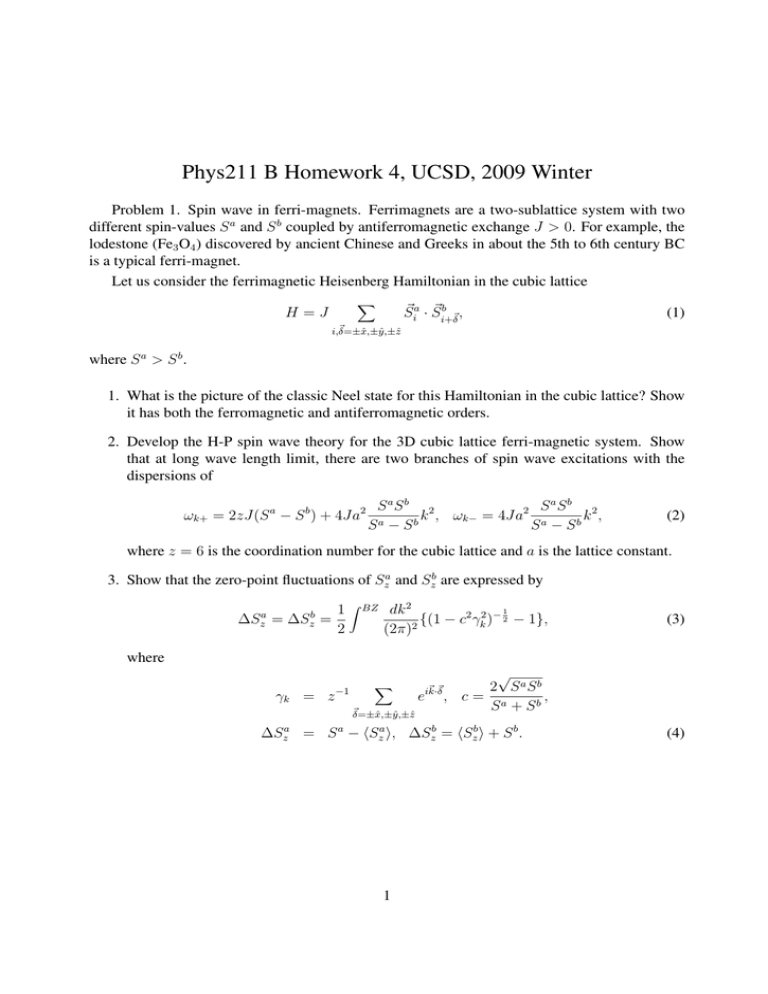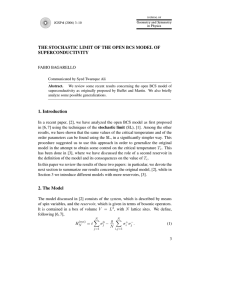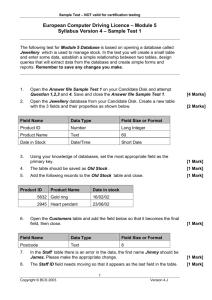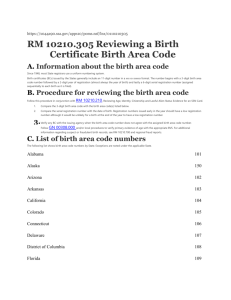Phys211 B Homework 4, UCSD, 2009 Winter
advertisement

Phys211 B Homework 4, UCSD, 2009 Winter
Problem 1. Spin wave in ferri-magnets. Ferrimagnets are a two-sublattice system with two
different spin-values S a and S b coupled by antiferromagnetic exchange J > 0. For example, the
lodestone (Fe3 O4 ) discovered by ancient Chinese and Greeks in about the 5th to 6th century BC
is a typical ferri-magnet.
Let us consider the ferrimagnetic Heisenberg Hamiltonian in the cubic lattice
~a · S
~ b ~,
S
i
i+δ
X
H=J
(1)
i,~
δ=±x̂,±ŷ,±ẑ
where S a > S b .
1. What is the picture of the classic Neel state for this Hamiltonian in the cubic lattice? Show
it has both the ferromagnetic and antiferromagnetic orders.
2. Develop the H-P spin wave theory for the 3D cubic lattice ferri-magnetic system. Show
that at long wave length limit, there are two branches of spin wave excitations with the
dispersions of
ωk+
a b
S aS b 2
2 S S
k , ωk− = 4Ja a
k2,
= 2zJ(S − S ) + 4Ja a
b
b
S −S
S −S
a
b
2
(2)
where z = 6 is the coordination number for the cubic lattice and a is the lattice constant.
3. Show that the zero-point fluctuations of Sza and Szb are expressed by
∆Sza
=
∆Szb
1Z
=
2
BZ
1
dk 2
{(1 − c2 γk2 )− 2 − 1},
2
(2π)
(3)
where
γk = z −1
X
~
δ=±x̂,±ŷ,±ẑ
e
i~k·~
δ
√
2 S aS b
,
, c= a
S + Sb
∆Sza = S a − hSza i, ∆Szb = hSzb i + S b .
1
(4)
Problem 2. Pseudo-spin representation for the BCS state of superconductivity.
1. Consider the BCS trial wavefunction for the conventional superconducting states. Let us
parameterize the uk and vk in terms of polar and azimuthal angles as
uk = cos
θk
θk
, vk = sin eiφk .
2
2
(5)
~k .
Let us consider (uk , vk ) as the pseudo-spin wavefunction for a pseudo-spin- 12 operator S
Calculate the expectation values for the z and xy-components, i.e., Sz,k and S⊥,~k respectively, in terms of θk and φk . Express the expectation value hH − µN i in terms of the θk
and φk .
~k subject to the pseudo2. Show that the system is equivalent to a set of pseudospin- 21 S
magnetic field Hk whose z- and xy-components are given as
Hz,k = k − µ, H⊥,~k = −
1X
V~ ~ 0 hS ~ i,
2 k0 k,k ⊥,k
(6)
3. Verify that rotation of all “spins” around the z-axis by the same azimuthal angle leaves the
energy of the system unchanged. Show that in the case of V~k,~k0 = V0 > 0, the normal state
~~ ∼ ẑsgn(k − µ)) is the true ground state.
ground state (S
k
4. In the case of V~k,~k0 = V0 < 0, verify that the “mean-field” solution of the spin problem (each
~k points along the corresponding field Hk ) reproduce the BCS gap equation at (T=0K).
S
~~ i in the momentum space for the BCS ground
5. Sketch the pseudo-spin configuration hS
k
state as a function of the magnitude of momentum k. And try to appreciate this beautiful
picture. This picture was develop by P. W. Anderson.
2
Problem 3. (Optional for extra credit) Fluctuations in the Ginzburg-Landau (GL) framework. Consider a superconductor near Tc so that the free energy functional is described by the
GL form as
F (∆, T ) = Fnormal +
Z
d3 r α(T )|∆(r)|2 +
β
|∆(r)|4 + γ(T )|∇∆(r)|2 .
2
(7)
1. Using the GL energy functional, show that the fluctuations of the order parameter ∆(r)
have the general form
|~r − ~r0 |
const.
exp { −
h∆ (~r)∆(~r )i =
}.
|~r − ~r0 |
ξGL(T )
∗
0
(8)
2. Evaluate (to an order of magnitude) the ration R of the fluctuation of the order param3
eter over a volume ∼ ξGL
(T
) to its spatial average, i.e., evaluate the quantity [hA2 i −
R
2
2
(hAi) ]/(hAi) where A = V d3 r∆(r) and V ∼ ξ 3 (T )GL .
3. Using the results for the GL parameters in the lecture notes, show that
1
(1 − T /Tc )− 2
,
R∼
ξ 3 (0)kB Tc
const. dn
d
(9)
where dn/d is the density of states in the normal state at Fermi energy, ξ(0) is the zerotemperature coherence length which is roughly the Cooper pair size.
4. Assuming that the constant is of order of 100, estimate the order of magnitude of the value
of 1 − T /Tc at which R becomes of order of 1 for clean Al with the parameters (ξ(0) ∼
104 A◦ , Tc /Tf ∼ 10−4 ).
You can see the region where the fluctuation is important is extremely small. This is why
the simple mean field type BCS description is so accurate for many conventional superconductor. In other words, BCS was lucky. But this does not apply to high Tc superconductors.
3
Problem 4. Macroscopic coherence in superconductors.
~ t) and describe by a
1. Consider a single particle of charge e moving in a vector potential A(r,
iφ(r,t)
Schroedinger wave function χ(r, t) = |χ(r, t)|e
. Defining the “velocity” v(r, t) as the
ratio of the expectation values of the electric current and the electric charge density, show
that
v(r, t) =
eA(r, t)
h̄
(∇φ(r, t) −
).
m
h̄
(10)
2. Suppose that the region in which the particle moves is multiply connected, e.g. a torus.
Show that the integral of v(r, t) around a closed path confined to the region must satisfy the
relation
I
v(r, t) · dl = (n − Φ/Φ00 )(h/m),
(11)
where Φ is the flux threading the path, Φ00 = h/e and n is an integer. In the case of Φ = 0,
show that if the charge density is constant on the path, this condition is the same as the
quantization of angular momentum.
3. With the same definition of v(r, t) as in part (1), show that the condition of Eq. 11 continues
to hold for a many body system in which all the particles occupy the same single particle
state χ0 (r, t) (e.g. in the case of BEC). However, in general no such condition can be
derived when the particles are distributed over many different states.
4. With the intuitive interpretation of the BCS wave function as describing a “BEC” of dielectronic “molecules”, and keeping the same definition of v(r, t) as in part I, (but not
necessarily Eq. 10), how would you expect Eq. 11 to be modified?
4






